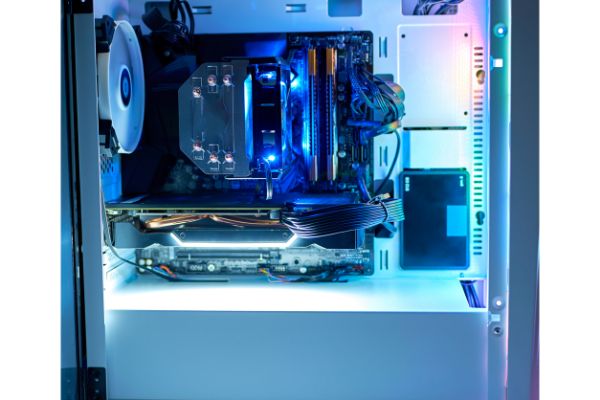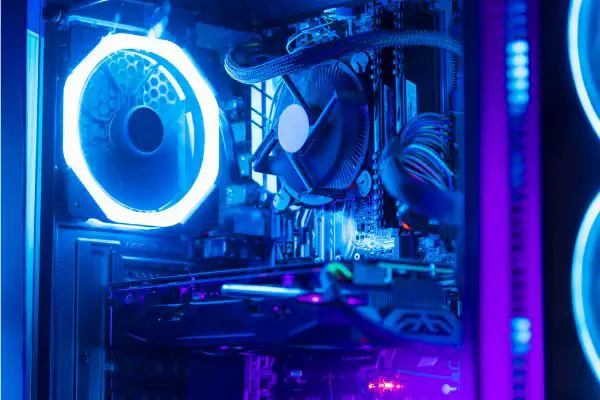Disclaimer: This post may contain affiliate links, meaning we get a small commission if you make a purchase through our links, at no cost to you. For more information, please visit our Disclaimer Page.
The desktop PC case may seem innocuous at first, but it is an important part of the overall computer setup. It keeps components grouped together as needed for the unit to run, keeps things physically stable and protected against impacts, and helps to keep things cool by managing or directing airflow across the space properly.
Additionally, a PC case can be a great way to show off one’s personal tastes or personality. With all of that in mind, some hobbyists might wonder about the difficulties they can expect to encounter when swapping out one case for another.
We’ll take a look at the possible level of effort it might take to switch out a case, whether it might be worth it to do so in certain circumstances, and how one might go about transferring a pre-built machine into another case.
We’ll also touch on how long you might expect your average PC case to last.
Table of Contents
Can You Swap PC Cases?
Yes, it is possible to swap PC cases. This is the short and sweet answer. But, as you might expect, there’s a bit more to it than just that.
As we delve into the article, we get deeper into just how you can swap a PC case, and how you might be able to measure the difficulty of such a task.
Before we talk about how hard it might be to do it, this is a good time to go over some of the preliminary work you should do. Doing some of this prep work can cut down on the difficulties that you might face later when it is time to make the actual switch.
It can also save you from the hassle of messing something up in the process, or causing one or more of your components to take damage.
1. To start, make sure you are properly grounded before doing any kind of swap of the components. Switching cases means exposing some of the hardware, and you don’t want to short anything out by carrying an electrical charge with you.
Of course, everything should be unplugged as well, but take the added precaution of grounding yourself.
2. If your current case is quite old, consider cleaning it off to get rid of excess surface dust before you take anything apart.
3. Besides cleaning off the case, you may wish to use this opportunity to clean the parts thoroughly as well. You’ll have the old case opened up anyway, and it is a good time to make sure everything is clean before you transfer all of the components to a new home.
4. Your new case might be quite different from the old one, so it is important to ensure that you don’t mix up the screws from one case for those of the other.
5. Additionally, it is a good idea to plan how you will manage all of your cables ahead of time. This will make it somewhat easier or quicker to transfer everything over, and you may spend less time with the new case open and the parts exposed.
There is some additional work to do and other things to keep in mind, but they will mostly relate to things you should do when you’re making the actual swap between one PC case and another.
We will cover some of these aspects in the appropriate sections.
Is It Hard To Switch PC Cases?
The truth is, it can be hard to switch PC cases, but that isn’t necessarily a foregone conclusion to make.
How hard it is can depend a lot on your previous experience with swapping out components and how much knowledge you have about doing it.
Therefore, it is vital that you come prepared with at least the basic steps that you’re going to perform, especially if it will be your first time swapping out a case. If so, you may wish to get some help or advice from any acquaintance who has done it already, if that is possible.
Even if you’ll have to do it all on your own for the first time, you can make it easier by doing some of the prep work that we mentioned above. You may also be able to find guides that talk about swapping between your specific rig and another case, and these may be helpful to you.
However, most switches between different PC cases will have similar steps. In short, some knowledge, patience, and a methodical approach can make any PC case switch job relatively easy.
You can think of it as just putting a PC together in reverse, given that you’ll need to unplug everything and take components out of one case and put them in another.
One thing that some people might find helpful before they start the job is to take some photos of how your PC looks before you start dismantling anything.
In fact, it is a good idea to do this even before you do most of the steps that we outlined above. Your computer is already put together at this point, and you know how it should look when everything is hooked up and in working order.
It doesn’t have to be hard, but how hard it is can depend on your experience. There are a few things to keep in mind to make sure that everything goes smoothly:
1. Treat the swap like building your first PC. This mindset can help you take extra care. Go slowly and methodically, and check and double-check everything as you move components over.
The last thing you want is to go to all of this trouble only for the computer not to turn on. Then, you’d have to work your way back through the process to find out where the error comes from.
2. If you’re careful, you can move components like the cooler, CPU, and RAM together along with the motherboard without disconnecting each thing.
This can save you some time and work that you’d spend on disconnecting and reconnecting things properly.
3. Pay particular attention to any wiring or connections that you’ll need to make to get everything going properly in the new case. This is one of the areas where it might be the easiest to mess up, especially if you’re doing a swap for the first time.
4. Most of making a case swap involves unscrewing and removing parts from one container and screwing them into another. If you keep the above tips in mind, it should not be extremely difficult to switch cases.
Is It Worth It To Change PC Case?
Only individual users can really answer this question for themselves. However, there are a few reasons why you might want to switch your case. One important reason is if you want to upgrade your rig by adding more or larger hardware to it.
For this to work, you may need more space inside a bigger case. If you do plan to do so, it is a good idea to take measurements of everything that you can first.
This includes dimensions for new components and the recommended physical space you’ll need in order to seat them all comfortably and securely without jamming them inside a cramped case.
Second, you might want to swap to a case that cools off your components better than your current one. This might be particularly true if you are dealing with an original manufacturer’s case. While such cases are certainly adequate, they may not provide the best in airflow.
A new, aftermarket or custom case may give you the cooling power that you need. It may also have space for extra fans.
Third, perhaps you just want to make the computer case an extension of your personal style. This is where the aesthetics of the PC case can come into play.
Different cases can have designs, patterns, colors, graphics, and much more that can help you express yourself without needing to do much work on the shell itself.
How Long Do PC Cases Last?
The true answer to this question is variable, but any PC case could last for as long as a user might need it to. That is to say, barring any damaging impacts, spills that could get into the case, or other problems, there is no reason to think the case itself will fail at any point.
In rare situations, you may find that some inexpensive cases might bend or warp, but even this sort of thing takes a long time.
The only other things to watch out for are the buttons and ports. While these things should also last a long time, their natures mean that they could fail after many years of repeated use. Even so, you should be able to replace these components without needing a whole new case.
Can I Transfer My Pre-Built PC to Another Case?
Yes, it is possible to transfer this kind of computer to another case. You can go about in much the same way that you would if you were transferring a computer that you put together yourself. You’ll use many of the same steps, but there are still some things to keep in mind.
For one, you might need to do some research to make sure your current power supply unit will fit in the new case.
Additionally, it is a good idea to make sure that all the power cables will be long enough for your needs when they go into the new case. Finally, make sure that everything in your current setup can line up with the buttons on the new case.
Conclusion
PC cases are designed by most manufacturers to be robust, hard-wearing containers that protect everything inside them for years. Sometimes, users just want to switch to something that looks different.
They might also need more space or better options for airflow. Whatever the situation, there are ways that each individual can take apart their own cases and swap them for new ones without too much hassle.


